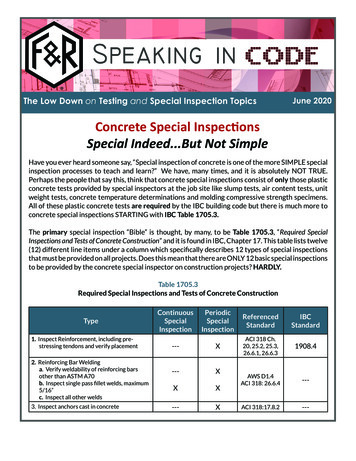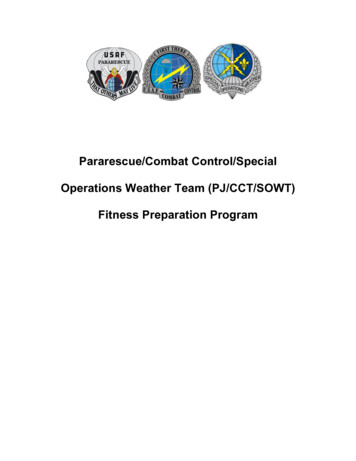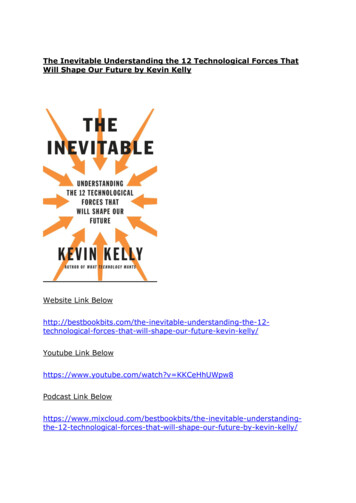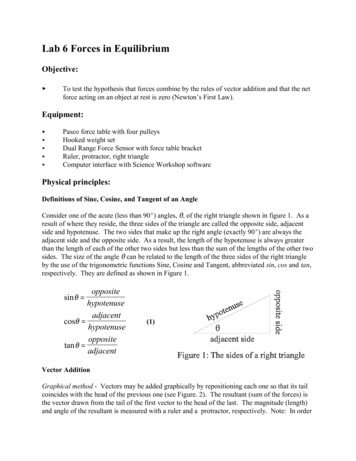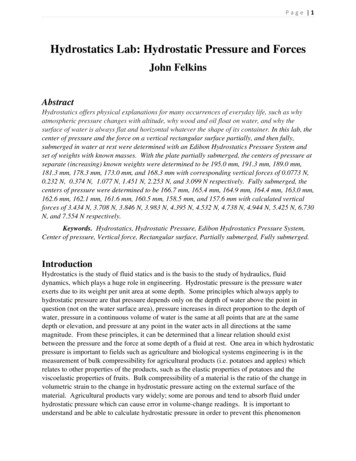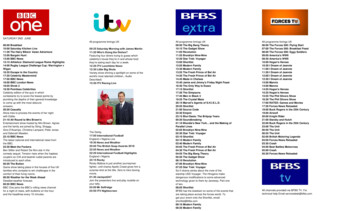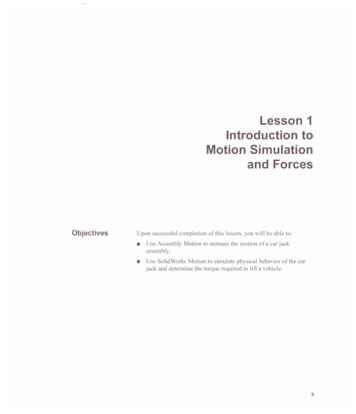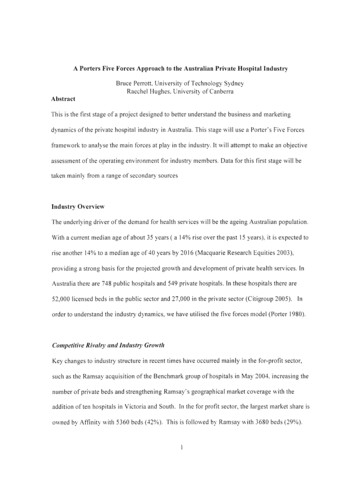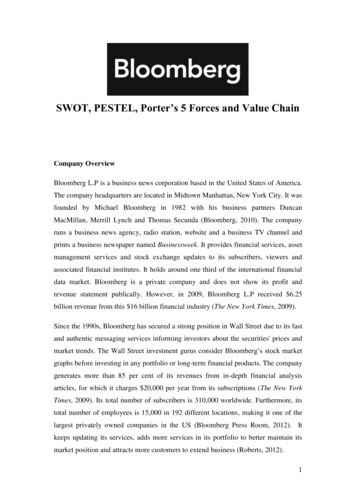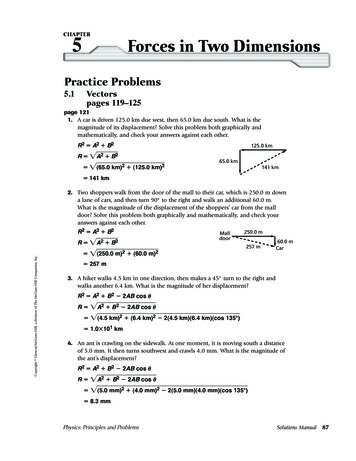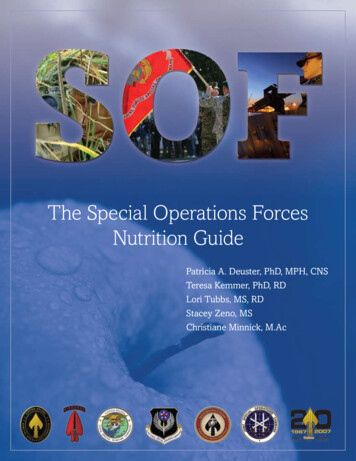
Transcription
The Special Operations ForcesNutrition GuidePatricia A. Deuster, PhD, MPH, CNSTeresa Kemmer, PhD, RDLori Tubbs, MS, RDStacey Zeno, MSChristiane Minnick, M.Ac
iAcknowledgementsMany people have contributed to this revised guide, and it is difficult to list all those who have made small contributions. However, wemust acknowledge those who have made major contributions. First, wethank LtCol Charity Thomasos, RD, USAF for her comments and suggestions on multiple chapters and her efforts on chapters 11 and 12. Wethank our primary points for contact at the SOF Commands who arrangedand coordinated our site visits, to include LCDR David C. Krulak, MCfrom MARSOC, MAJ(P) Anthony Littrell, MC, USA from USASOC, LTCRobert Lutz, MC, USA from JSOC, MAJ Keith E. Schlechte, MC, USAF fromAFSOC, and CDR Lanny Boswell, MSC, USN from NAVSOC. We offer a veryspecial thanks to LCDR Jim Mucciarone, MC, UMO/DMO, Senior MedicalOfficer for Naval Special Warfare, who provided invaluable feedback on thechapters. We recognize MAJ Dirk Geers, Special Operations and PersonnelRecovery Office in Belgium, who used the previous Navy SEAL Guide andposed many questions before the new guide was begun and provided excellent comments based on his use of the information for deployments. We alsothank CAPT Roger Herbert, Commander of NSW Training who spent timediscussing the importance of nutrition to BUD/S training. Ms. Jennifer Davisis recognized and thanked for her dedication to the Excel spreadsheets thatwere developed specifically for this effort—she did a wonderful job. In addition,we thank Mike Bottoms, Editor, Tip of the Spear.We wish to thank USSOCOM for sorting through and sending us pictures for use in the SOF Guide. Also CAPT Pete Van Hooser for his recommendations and efforts in securing quotations from the SOF community.Lastly, we recognize and thank all the persons at USSOCOM who wereinstrumental in the administration of this effort for their patience overthe course of the project: COL Rocky Farr, Mr. Robert Clayton, Mr. DavidSaren, and Mr. Thomas Hindes.
iiAuthorsDr. Patricia Deuster, PhD, MPH, CNS, is a Professor and ScientificDirector for the Consortium for Health and Military Performance in theDepartment of Military and Emergency Medicine at the Uniformed Services University of the Health Sciences, in the F. Edward Hébert Schoolof Medicine in Bethesda MD. She was the author of the first US NavySEAL Nutrition Guide sponsored by US Special Operations Command,and because of its success, was commissioned to update the nutritionguide for the United States Special Operations Commands (USSOCOM).Dr. Deuster, a Certified Nutrition Specialist, has conducted research in thearea of sports and warrior nutrition for over 25 years and has publishedwell over 100 peer-reviewed papers relating to stress, nutrition, physicalperformance in the military. She has been a tennis professional, nationallyranked marathoner, qualifier for the First Women’s Olympic Marathon Trials, triathlete, sky diver with over 100 jumps, and world wide scuba diver.In addition, she is an invited speaker throughout the country on sports nutrition and performance. Her dedication to sports, nutrition, and scientificendeavors, and her long-term relationship with the USSOCOM make heruniquely qualified to oversee this revision of the SOF Nutrition Guide.Dr. Teresa Kemmer, PhD, RD, U.S. Army Retired, is currently an Assistant Professor, Department of Nutrition, Food Science and Hospitality,South Dakota State University (SDSU), Brookings, SD. Dr. Kemmer hasprovided consultative nutrition services to warrior athletes throughout hercareer and brought recognition to the importance of the military’s role innutrition assessments and therapy in support of Stability, Security, Transition, and Reconstruction Operations. She designed and executed nutritionassessment research/support programs in Honduras, the refugee campsalong the Thailand/Burma border, American Samoa, and rural villages inThailand. She assisted in the design and implementation of the ongoingtraining program for the San Antonio Military Pediatric Center (SAMPC)Residency Program in Honduras. She incorporated a research base intothe training program to ensure that data obtained was valid and could beused by the Honduran Ministry of Health (MoH) and governmental andnongovernmental organizations to establish policy and programs. Today,this training program continues to be executed three times a year withinthe remote areas of Honduras in collaboration with the Honduran MoH,Joint Task Force Bravo Medical Element, SAMPC, military dietitians, andSDSU. She has not only been instrumental in international nutrition research initiatives but has designed and taught classes to ensure dietitiansand other medical professionals are prepared to recognize and managemacro- and micronutrient deficiencies common in developing countries.Lori Tubbs, MS, RD, CSSD, CSCS, has been working in the field of healthpromotion and sports nutrition with the Naval Special Warfare communityfor the past nine years. She is a registered dietitian (RD) and a certified spe-
iiicialist in sports dietetics (CSSD) and strength and conditioning (CSCS). Shecurrently works with the SEAL community and has been tasked to initiate ahuman performance program that includes full time nutrition support. Shehas worked as the nutrition program manager for Navy-wide health promotion and is a subject matter expert in sports nutrition for Navy EnvironmentalHealth Center (NEHC). She has conducted training in nutrition and wellnessglobally for Navy personnel, and has deployed on several aircraft carriersand smaller ships to support the Navy fleet. An environmental nutrition appraisal called Choosing Healthier Options for Wellness (CHOW) developedin 2005 was used to assess healthy foods available on military bases forservice members, beneficiaries and contract workers. Her other initiativesinclude the “Healthy Alternative” Navy vending program and the SEAL Recovery Meal Program. Lori is an avid year-round athlete who has competedin several triathlons throughout the United States, to include Ironman LakePlacid, along with numerous marathons and outrigger canoeing. She creditsmost of her success to support and advocacy by many military leaders formaking the military a better environment nutritionally. Commodore/CAPTPete VanHooser, a Navy SEAL, has been influential in supporting the nutrition component of human performance for the SEAL community.Ms. Stacey Zeno, MS, is a graduate of American University in Washington, D.C. with a Masters of Science in Health Promotion Management.She supervises the Human Performance Laboratory at Uniformed Services University of the Health Sciences in the Department of Military andEmergency Medicine. In addition, she is a certified personal trainer whoworks with recreational and club sport athletes. Ms. Zeno frequently delivers seminars on nutrition and works closely with female and male athleteswho have eating disorders. Sports have always been a passion and a keycomponent of her life. She has participated in track and field as well astennis, but is currently active with softball and weight lifting.Christiane Minnick, BFA, MAc, spent over twelve years working asa communications design professional in the fields of graphic design, advertising, and marketing. In 2003, she enrolled at Tai Sophia Institute forthe Healing Arts and graduated in 2007 as a Master of Acupuncture. Nowa licensed acupuncturist, she is building her private practice in downtownSilver Spring, Maryland. Christiane believes there is a connection betweengraphic design and acupuncture: in both fields, a holistic approach—onewhich emphasizes not just numerous disparate pieces of information,but how that information adds up to create and transcend the whole —iscrucial when developing a plan for a design project or an acupuncturetreatment. Just as a visual solution must emerge from this information toform an identity or a message, so must those in health professions notethe themes and core beliefs that run through each person’s own humanexperience (presented as information on a physical, emotional, social, orspiritual level) to identify what may be contributing to their disharmony.Christiane has a long-standing interest in the myriad ways, which includesnutrition, a person can influence their own health and wellness, and wishesto thank Patricia Deuster for the opportunity to work on this project.
ivExecutive Summary1 The Warrior Athlete Proteins are essential for building and repairing bodytissues; however, excess protein is converted to fat.Special Operations Forces (SOF) are “Warrior Athletes,” the ultimate athlete. The physical and mentaldemands imposed by SOF training and missions requireappropriate nutritional habits and interventions so that,under the most rigorous conditions, performance isoptimized, and health is preserved. Restore fluid balance by taking in enough liquids toreplenish weight (pounds) lost plus an additional 25%.This chapter serves as an introduction to the specialized needs of SOF and the information to be presentedin The Special Operations Forces Nutrition Guide.2 Balancing the Energy Tank Balancing energy intake and expenditure can bedifficult when activity levels are very high and alsowhen activity levels are very low, such as duringisolation. Typically, body weight remains constant whenenergy intake equals expenditure. To lose or gain one pound of weight, 3,500 caloriesmust be expended or consumed. Calculating Resting Energy Expenditure (REE) andthe intensity of daily activities gives an accurateestimate of how much energy an operator mightexpend in one day. The Body Mass Index (BMI) is a clinical tool forassessing body fat composition and classifies individuals into underweight, normal, overweight, andobese categories.3 Fueling the Human Weapon Carbohydrates (CHO) are the vital fuel for endurance and resistance activities, competitive athleticevents, mental agility, and healthy living. Fats, the primary form of stored energy, are essential, but should be eaten in moderation. Performance decrements begin when only 2% ofbody weight has been lost.4 High Performance Catalysts Vitamin and mineral needs can be met by eating avariety of foods. Vitamin-mineral supplements do not provide energy. Vitamin-mineral supplementation is warranted onlywhen energy balance is not met through the diet. Mega-dosing on vitamins and minerals can be detrimental to health and performance. Foods naturally high in antioxidants (fresh andcolorful foods) should be eaten daily.5 Nutrient Timing and Training The timing of nutrient delivery is critical to sustaining performance. The Refueling Interval (RFI) is the 45 minutes afterfinishing a workout. Eating during the RFI will accelerate recovery andrestore energy for the next day’s workout. A daily diet that is balanced and nutrient-dense willensure better performance and optimal recovery. CHO foods and beverages that have a moderate tohigh glycemic index, such as sport drinks, raisins,honey, bananas or potatoes are ideal recovery foods. Adding protein to the recovery meal will helpstimulate protein synthesis to assist in rebuildingmuscle (anabolism). For exercise longer than 90 minutes, consume 50
vgrams of CHO and 12 grams of protein as food ordrink immediately during the RFI and 50 grams ofCHO every 2 hours for 6 hours. Adequate fluids must be ingested after a mission. Fluid replacement beverages should contain sodium and potassium. Sports bars, gels and drinks are lightweight, portable and easy to eat during SOF operations.6 Optimal Choices for Home Chow Foods eaten at home can impact mission performance. Smart shopping is the first step towards healthymeal preparation. Most recipes can be modified to improve nutrientcomposition. Use nutrition labels as a guide for making smartfood choices. Every meal is important for overall health andperformance.alertness without promoting weight gain. Keep nutrient dense snacks at home, work, or “onthe go.” Snacks for night operations should include foodslow in carbohydrate and high in protein. Snacks high in water, such as fruit, are great for warmweather operations. Snacks high in carbohydrate are good to consumewhen exercising in the cold. Avoid high-fat snacks during special operations.9 Secrets to Keeping Leanas a Fighting Machine Consumption of carbohydrate (CHO) in definedamounts is the most important fuel strategy for allforms of exercise. Depletion of glycogen stores will result in poorperformance in the weight room and endurancetraining sessions, such as a pack run. Aim for as many servings of fruits and vegetablesas possible. Improper nutrient intake and low muscle glycogenstores may increase the risk of musculoskeletalinjuries.7 Optimal Choices for Eating Out CHO ingestion improves the use of amino acidswhen they are ingested together. Not all restaurants are equal. Choose wisely. Eating out can be healthy if careful meal selectionsare made. Drinking too much plain water can pose performance pitfalls during prolonged missions/exercisesessions that involve constant movement. Selecting fruits and vegetables as a part of themeal adds vitamins, minerals and fiber, and helpsreduce fat and calories. Individual food preferences should be determinedto avoid gastrointestinal distress during trainingand operations. Fast food restaurants have healthy alternatives tothe high-fat burger and fries. Make sensible foodchoices.10 Bulking Up8 Healthy Snacking Proper and consistent strength training, adequaterest and a balanced diet will provide the lasting edgewhen it comes to building strength and muscle mass. Snacking, or “eating between regular meals,” isimportant to help maximize performance andmaintain mental and physical acumen. Eating a wide variety of foods and matching energy intake with energy output will provide optimalnutrition for building muscle. Hea
of Medicine in Bethesda MD. She was the author of the first US Navy SEAL Nutrition Guide sponsored by US Special Operations Command, and because of its success, was commissioned to update the nutrition guide for the United States Special Operations Commands (USSOCOM). Dr. Deuster, a Certified Nutrition Specialist, has conducted research in the


